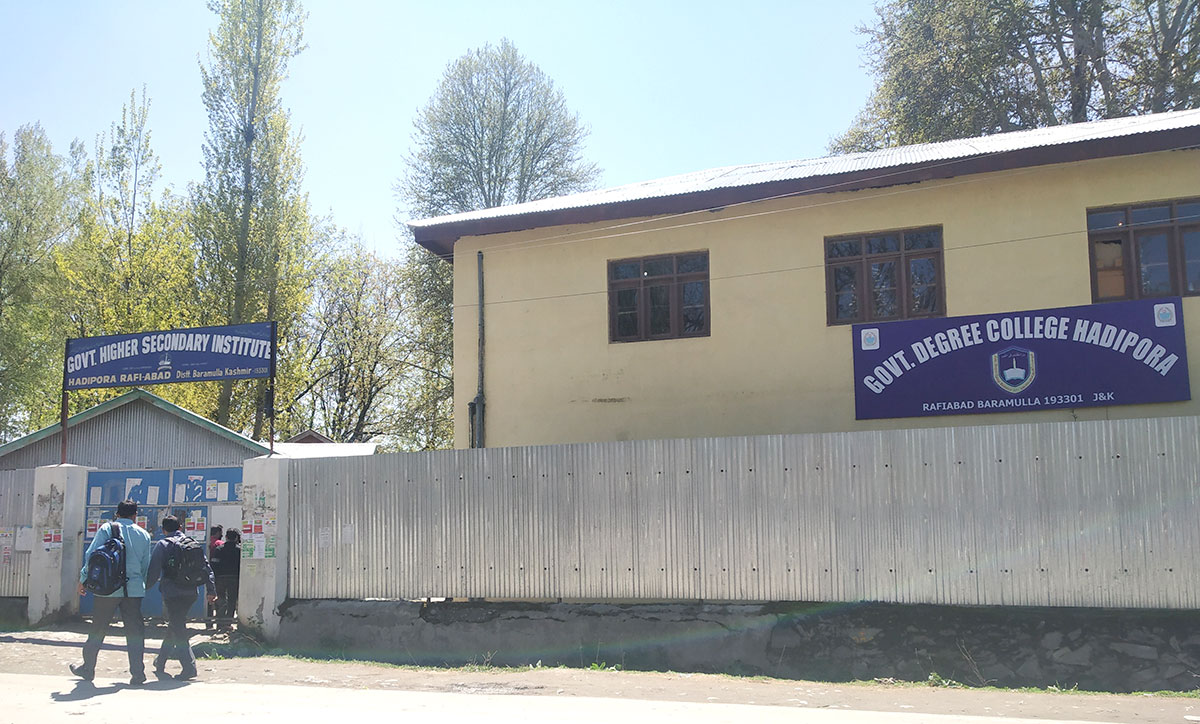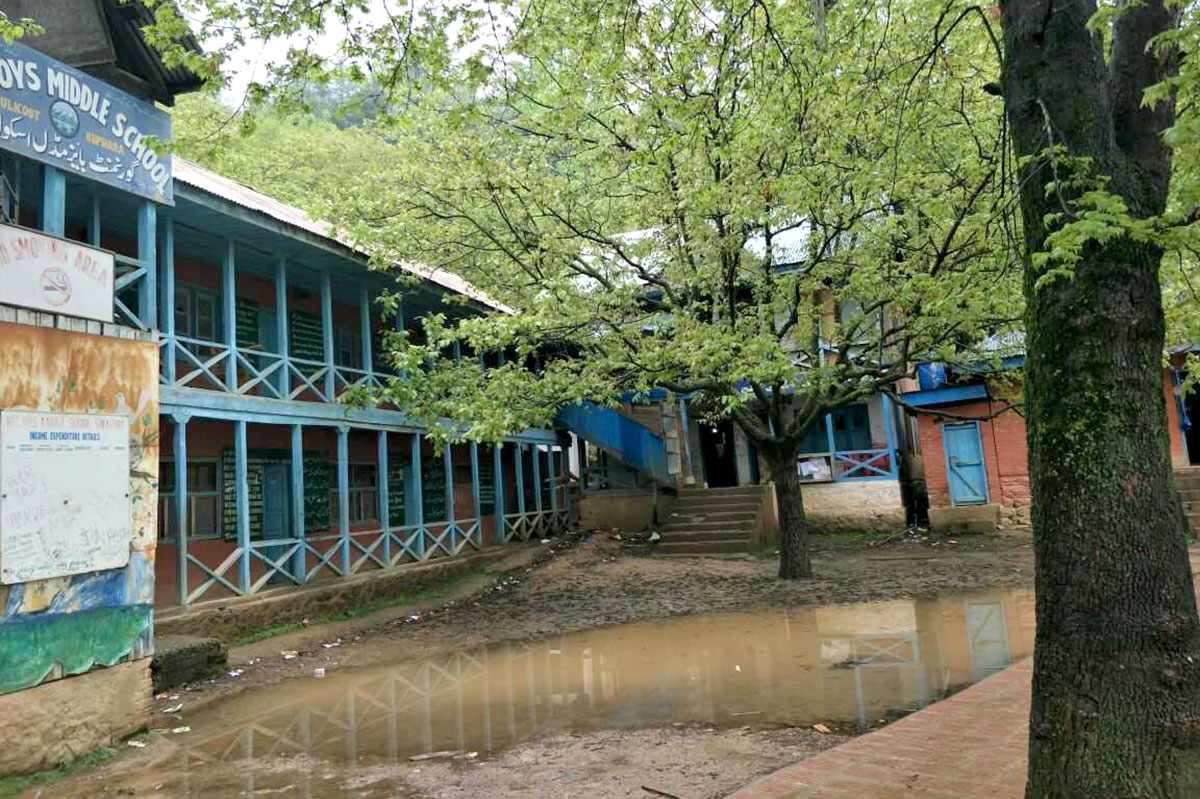All of sudden, there is a huge race for more colleges. With additional 52 colleges announced by the governor in recent months, the number of colleges in 22 districts across the state has gone up to 147. But most of the colleges announced earlier are still operating from a few rooms which have hugely impacted the quality of education they impart, Faheem Mir reports

March 20, 2019, was a rainy day. The students of state-run Degree College at Uri were roaming in the college corridors and trying to get some space that would shelter them. The college lacks space and limitation of classrooms keeps a lot of many out and away.
Set up in 2005, with arts and science streams, this college is one of the various ‘gains’ that politicians ensured for their politics. Still, 14 years later, it operates from six classrooms for 700 students. Even if 100 students can accommodate in one classroom, it still will have 100 to stay out.
Then the students have different subjects and different semesters. This stratification makes it all the more difficult to manage the space better.
Students say they have stopped complaining about a shortage of space. Instead, they are counting days to complete their degrees. “We have a shortage of space here and we are facing problems and are now used to it,” PathanMubashir, a fifth-semester under-grad said.
Students now prefer to enrol in Baramulla colleges. “I first went to Uri College for the admission but then moved to Baramulla,” a student Ibrar Aijaz Mir said. “I am presently staying at a college hostel in Baramulla”.
In 2011, the government sanctioned a women college in frontier Kupwara district. The flip side of the great intervention is that the college is still working from the middle school Sulkoote. With more than 700 students and only 16 teachers, this college operates from five classrooms as the middle school refused to offer to any of the other nine rooms it owns.
“There are only two washrooms for more than 800 school and college students and the staff,” a female student said. The school students alleged the interference of college effects their education.
These are just the two cases of how the colleges have failed to improve quality education. These stand reduced to degree shops.
Miles away in Tral (Pulwama), a degree college was established in 1988. Almost 31 years later, it still has only 12 classrooms for 1200 students!
“The students are surely facing problems in getting a quality education,” a college official, who wishes to stay anonymous, said. “Sometimes we take classes in the staff room or take zero periods or combine classes”.
Academics apart, the poor infrastructure impacts the co-curricular activities.
A general perception is that the government sanctions these colleges for political gains. Government is establishing new schools and colleges, even after finance department’s disagreement on several orders, sources said.
Recently the state government announced the establishment of 52 new degree colleges across the state which increased the number of overall colleges to 147 excluding private, engineering and BEd colleges. The new 52 colleges came in two orders.
There is a demand that the government, instead of setting a new college, must improve the quality of earlier ones.
“The government teachers affiliated with RAMSA recently received their salaries after six months and what they expect by announcing new colleges. Should the government do justice with the staff and the students? How about those who are studying under the open sky for years now?,” one angry person wrote on his Facebook wall.
Almost all the 22 districts got one or more colleges and Ganderbal was the only exception. With six new colleges, Jammu has now 19 state-run colleges. Udhampur, which lacks even half of Jammu population, has 19 colleges; four of them were announced recently.
Even Rajouri has now nine colleges. “There was no need of establishing new three colleges in the region,” resident Raja Waseem said. “When I joined the Islamic University at Awantipora, I felt the lack of exposure because I had not come out of Rajouri ever.” The region is home to the Baba Gulam Shah Badshah University and most of its students are from Kashmir.
In 2018, Samba had just one college for three lakh population in Vajpaypur. Two months later, it has three more, one each at Purmandal, Ramgarh and Ghagwal.
In the new list of colleges, Ladakh got two additional colleges and Kashmir region got 24. Srinagar had eight colleges and got three more for Hyderpora, Idgah and Allochibagh. One of the earlier announced colleges in Bagh-i-DilawarKhan operates from three rooms of MP higher secondary school since 2009.
With three more colleges for Anantnag, it has 11 now: Khanbal, Bijbehara, Dooru Shahabad, Kokernag, Uttersoo, VailooLarnoo, Chittisingpora, Ashmuqam, Mattan and Verinag. Dooru is barely 5km away from Varinag. The distance between Verinag and Kokernag is 22 km. Vailoo is a 40-minute walk from Kokernag. Mattan is a few minutes’ drive fromAshmuqam, Uttersoo is only 16 km from Mattan and Chattisinghpora and Ashmuqam is barely half an hour drive away. The district has more than a million population but it is still smaller than Srinagar.
The same situation rules the state. Pulwama that has now six colleges has half of them literally less than 30-minutes drive away. These are Awntipore, Pampore and Rajpora. All the colleges in Kulgamdistrict are within the 7-km radius.
The Bandipora has six colleges – Ajas, Hajin, Sumbal, Bandipora, Gurez and Tulail. Three of them Sumbal, Hajin and Ajas are a conjoined cluster, which, in itself is only 18km away from major college in Bemina.
In the twin north Kashmir Baramulla and Kupwara districts, the colleges of Dangiwacha and Hadiporaare separated by a 3 km road. Since its establishment in 2008, the Hadiporacollege, operating from the local Higher Secondary, has ‘hatched’ only one batch of graduates.
Since the degree college at Baramulla and Sopore are the oldest, well-established and have their own history, students prefer to get enrolled, there. By sanctioning four new colleges the number increased to 12: Kareeri, Dangiwacha, Bomai and Boniyar.
In Kupwara, the college at Langate and Handwara are barely a few minutes’ walk away from each other.
More colleges do not necessarily mean more education. On the literacy rate front, the details are already known. Districts having not so huge number of schools have better literacy levels. In fact, Leh and Kargil have better literacy rates than Srinagar.
The rate race for setting up new colleges is making commoners happy but the people who have enjoyed colleges say it is mere politics.

“Four colleges in a district are enough for the population,” a University professor said. “We must improve the infrastructure and then permit to operate.” His experience is that students who had their college education away from home are sharper. “What is the fun for the student of schooling in the same village and then graduating from there,” he asked.
The mass college network might be helping in creating a lot of graduates but these eventually result in a huge compromise in the quality of a graduate. The lack of exposure is linked to the quality of evolution of a knowledgeable person.
“College means that the students should get the all-round development,” one teacher said. “He or she must have a lot of interaction with the students coming from different social and economic backgrounds and they must have access extra-curricular activities and should have all the basics.”
What makes the entire exercise interesting is that there is a dearth in the teachings staff. Most of the students are being managed by the staffers who are hired on a seasonal basis. The question is: if the government is managing the show of the older colleges using the contractual staff, how will it manage the new number?
Right now, officials said that the state-run college at Khanabal is the biggest in numbers – it has more than 6000 students. Rather than reducing the “burden” of this college, by announcing two more colleges, adding to its infrastructure would have been economic.
But the students of Uri must be happy. They have a sister college at Boniyar, barely a 30 minutes’ drive. They hope Boniyar may have better space!















